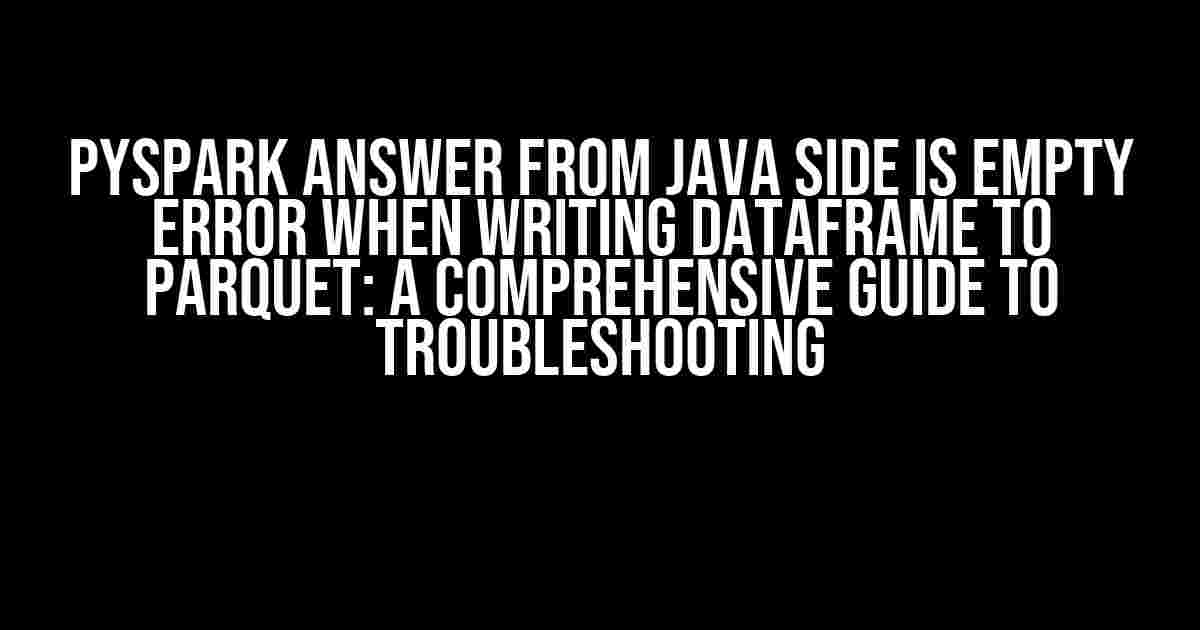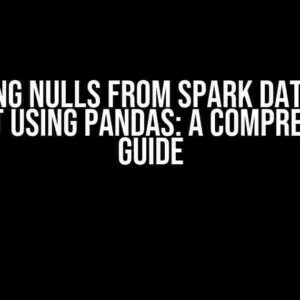If you’re reading this article, chances are you’ve encountered the frustrating “Pyspark Answer from Java side is empty” error when trying to write a Dataframe to Parquet. Don’t worry, you’re not alone! In this article, we’ll delve into the possible causes of this error, and more importantly, provide you with step-by-step solutions to overcome it.
What is the “Pyspark Answer from Java side is empty” error?
The “Pyspark Answer from Java side is empty” error typically occurs when you’re trying to write a Dataframe to Parquet using PySpark, and the Java side (i.e., the Spark Java API) returns an empty response. This error can be misleading, as it doesn’t provide much insight into the actual cause of the issue.
Possible Causes of the Error
Before we dive into the solutions, let’s take a look at some possible causes of the “Pyspark Answer from Java side is empty” error:
- Incorrect configuration of Spark session or Dataframe
- Missing or incorrect dependencies in the Spark runtime
- Issues with Parquet file format or compression
- Network connectivity problems between PySpark and the Spark Java API
- _Version incompatibilities between PySpark, Spark, and Java_
Troubleshooting Steps
Now that we’ve identified some possible causes, let’s go through the troubleshooting steps to resolve the “Pyspark Answer from Java side is empty” error:
Step 1: Verify Spark Session Configuration
Ensure that your Spark session is properly configured. Check that you’ve set the correct Spark version, and that the `spark.sql.parquet.writeLegacyFormat` property is set to `true`:
from pyspark.sql import SparkSession
spark = SparkSession.builder.appName("ParquetWriter").getOrCreate()
spark.conf.set("spark.sql.parquet.writeLegacyFormat", "true")Step 2: Check Dependencies and Runtime
Make sure you have the correct dependencies in your Spark runtime. Specifically, ensure that you have the Parquet library included:
from pyspark.sql import SparkSession
spark = SparkSession.builder.appName("ParquetWriter") \
.config("spark.jars.packages", "org.apache.spark:spark-parquet_2.12:3.0.0") \
.getOrCreate()Verify that you’re using the correct version of Spark and Java. You can check the Spark version using:
print(spark.version)Step 3: Inspect Parquet File Format and Compression
Check that your Parquet file format and compression settings are correct. You can specify the format and compression using the `format` and `compression` options, respectively:
df.write.format("parquet").option("compression", "snappy").save("path/to/parquet/file")Step 4: Network Connectivity and Java API
Verify that your PySpark application has proper network connectivity to the Spark Java API. Check that the Java API is running and listening on the correct port.
Step 5: Version Compatibility
Ensure that your PySpark, Spark, and Java versions are compatible. You can check the version compatibility matrix on the official Apache Spark website.
Solution 1: Disable Legacy Parquet Format
If you’re using Spark 3.0 or later, try disabling the legacy Parquet format by setting `spark.sql.parquet.writeLegacyFormat` to `false`:
spark.conf.set("spark.sql.parquet.writeLegacyFormat", "false")Solution 2: Use `coalesce` or `repartition`
Try using the `coalesce` or `repartition` method to reduce the number of partitions in your Dataframe before writing to Parquet:
df.coalesce(1).write.format("parquet").save("path/to/parquet/file")This can help reduce the amount of data being written to Parquet, which may resolve the “Pyspark Answer from Java side is empty” error.
Solution 3: Specify the Parquet File Format and Compression
Explicitly specify the Parquet file format and compression settings when writing the Dataframe to Parquet:
df.write.format("parquet").option("compression", "snappy").option("parquet.compression", "snappy").save("path/to/parquet/file")Solution 4: Increase the Spark Driver Memory
Try increasing the Spark driver memory to ensure that the Java API has sufficient resources to process the data:
spark.conf.set("spark.driver.memory", "4g")Conclusion
The “Pyspark Answer from Java side is empty” error can be frustrating, but by following these troubleshooting steps and solutions, you should be able to resolve the issue and successfully write your Dataframe to Parquet. Remember to check your Spark session configuration, dependencies, and runtime, as well as the Parquet file format and compression settings. If all else fails, try disabling legacy Parquet format, using `coalesce` or `repartition`, or specifying the Parquet file format and compression explicitly.
| Solution | Description |
|---|---|
| Disable Legacy Parquet Format | Set `spark.sql.parquet.writeLegacyFormat` to `false` |
| Reduce the number of partitions in the Dataframe using `coalesce` or `repartition` | |
| Specify Parquet File Format and Compression | Explicitly specify the Parquet file format and compression settings using `format`, `option`, and `parquet.compression` |
| Increase Spark Driver Memory | Increase the Spark driver memory using `spark.driver.memory` |
We hope this article has helped you troubleshoot and resolve the “Pyspark Answer from Java side is empty” error. Happy PySpark-ing!
Frequently Asked Question
Stuck with the infamous “Pyspark answer from Java side is empty” error when writing a Dataframe to Parquet? Don’t worry, we’ve got you covered!
What’s the primary reason behind the “Pyspark answer from Java side is empty” error?
The primary reason is usually due to the mismatch between the Spark version used in the Java/Scala code and the PySpark version. Ensure that both versions are compatible and match the installed Spark version.
How do I check the Spark version compatibility?
You can check the Spark version by running `spark.version` in your PySpark code or by checking the `pom.xml` file (if using Maven) or `build.sbt` file (if using SBT) for the Scala/Java project.
What’s the impact of not setting the correct Hadoop configuration?
If the Hadoop configuration is not set correctly, it can lead to issues with the Parquet writer, resulting in the “Pyspark answer from Java side is empty” error. Ensure that you set the correct Hadoop configuration, such as the Hadoop version and the `hive.metastore` properties.
Can I use the `repartition` method to avoid this error?
Yes, using the `repartition` method can help avoid the “Pyspark answer from Java side is empty” error. Repartitioning the Dataframe can help reduce the load on the Parquet writer and prevent the error. However, this method might not always work and should be used judiciously.
What’s the best way to troubleshoot this error?
The best way to troubleshoot this error is to enable debug logging, check the Spark UI for any errors, and verify that the Dataframe is not empty before writing it to Parquet. Additionally, you can try writing the Dataframe to a different file format, such as CSV, to isolate the issue.


